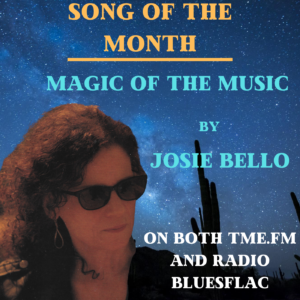Bluesflac is up and running, we don’t know why it stopped or what we did to get it working but we are back.
Sorry for loss of service.
Bluesflac is up and running, we don’t know why it stopped or what we did to get it working but we are back.
Sorry for loss of service.
Due to problems occurring after Windows update Bluesflac is currently down.
Sorry
We are working on the problem.
For the next 3 days Bluesflac will be off air as we repair clean modernize the studio.
Radio Bluesflac will be down for approx two weeks as from 23rd June.
Sorry for loss of service during this time but we will be coming back fresher and fitter.
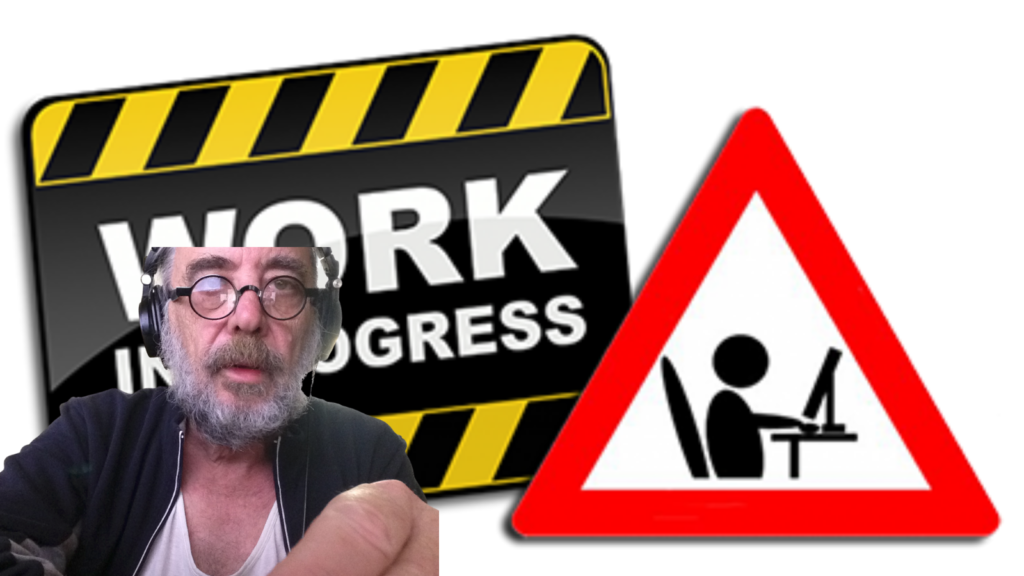


Yes Betsie Brown, a lovely lady who knows her Blues and the Blues World knows Betsie.
When asked to choose an album she replied “That’s easy” – “Howlin’ Wolf – The London Howlin’ Wolf Sessions”
That she chose the album that introduced me to “American” Blues made me go all “Goosey”.
But then I should not be surprised because Betsie and I once were accused of having a “Special Relationship”. Seeing as I have never met Betsie and we live on different Continents it wasn’t very special.
We do have a lot in common though.
Cuppa Joe, cuppa Earl Grey, Blues and an English education.
Oh and she doesn’t look like a Blind Raccoon.
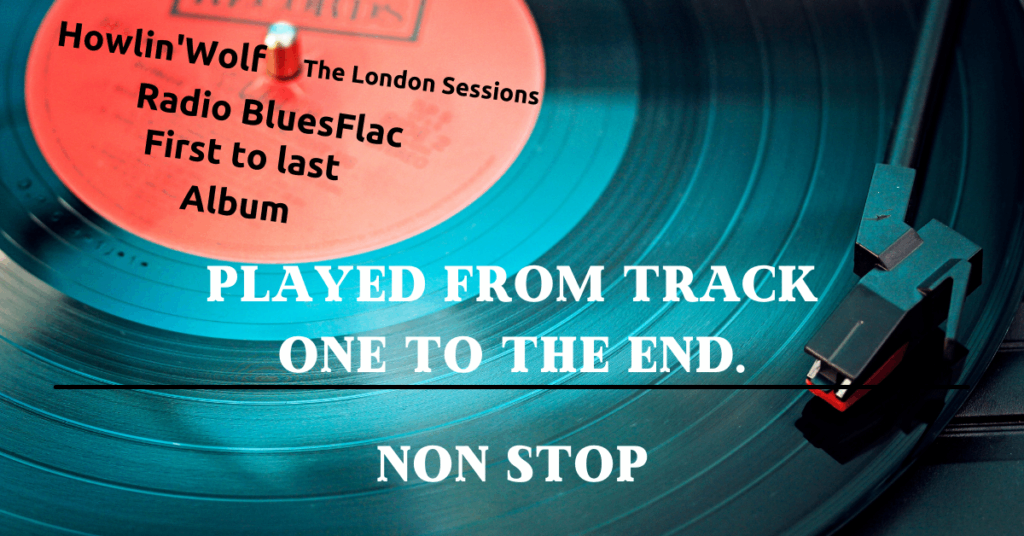
By Johnny Black (Classic Rock) July 16, 2020
Now revered as a linchpin moment in the history of the blues, Howlin’ Wolf’s 1970 London Sessions were recorded with Eric Clapton and various Stones and Beatles. This is the story, told by those who were there
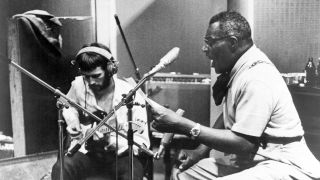
Howlin’ Wolf recording in London with Eric Clapton (Image credit: Michael Ochs Archives / Getty Images)
It all started with a chance encounter several months earlier at a show in San Francisco. Backstage at the gig, blues guitarist Mike Bloomfield of the Electric Flag introduced Eric Clapton to Chess Records producer Norman Dayron.
In the course of a rambling conversation about their blues heroes, Dayron floated the idea that he might be able to put together an album on which Clapton would play with the legendary Howlin’ Wolf. Clapton’s eyes lit up but there was one catch.
Nobody had yet suggested the idea to Howlin’ Wolf.
May 1, 1970 : Howlin’ Wolf, Hubert Sumlin, Jeff Carp, Norman Dayron and others fly to London.
Norman Dayron: When I had first told Wolf what I was thinking of, he thought it was a horrible idea. He didn’t know who these guys were, but we’d worked together, and he trusted me, so he came round to it.
In all there were about 10 people in our party, professional bluesmen from Chicago, in case any of the English guys Clapton had organised didn’t show up. As it turned out, I only needed to use Hubert and our 18-year-old harmonica wizard Jeff Carp. Myself and all of my musicians stayed at The Cumberland Hotel, and we had a small fleet of taxis organised to drive them down to Olympic Studios every day.
Hubert Sumlin: The company [Chess Records] in the States just wanted Wolf with Eric Clapton and the rest of the guys. They was going to leave me back. Eric made a statement, telegraphed these people. If I wasn’t going to be on there, he wasn’t going to be on there. So they said to me, “Hey man, pack your bags – you got to go!”
Norman Dayron: It was always my intention that Hubert would come with us. I was, by this time, an independent producer, so I controlled the budget, I booked the tickets. It’s conceivable that Leonard Chess may have had a private conversation with Hubert and may have said something like that to him, but I wanted him there.
Hubert had been concerned about what his role was going to be. I explained, before we left Chicago, that I wanted him to play rhythm guitar, and he was perfectly happy about that.
Eric Clapton: The guy that organised the session wanted me to play lead instead of Hubert Sumlin. Hubert ended up supplementing, playing rhythm, which I thought was all wrong, because he knew all the parts that were necessary and I didn’t.
Ringo Starr: Two memories are that Howlin’ Wolf was incredible! And his guitarist – he had this guitarist with him who was just so fuckin’ incredible. Eric was on the sessions and he just let the guy take it, y’know. It was really a moment to see, Mr Guitar himself bowing to this guy who really played the way [Eric] played.
May 2, 1970 : Olympic Studios, London, recording I Ain’t Superstitious, Goin’ Down Slow and I Want To Have A Word With You.
Glyn Johns (engineer): I had received a call from the fellow who, so-called, produced it. He was an American. His name was Norman Dayron and he proved to be a complete inadequate. He said that he wanted to re-record Howlin’ Wolf, using a bunch of English rock’n’roll musicians. He’d booked Olympic Studios and asked if I’d engineer it, and I said I would.
Norman Dayron: When I got to Olympic, one of the first things I realised was that their recording techniques were more designed for classical music than blues. They used lots of condenser microphones which did not give the kind of focused, sharp sound that we were getting at Chess. Regrettably, I was not subtle in making suggestions about how to change the sound.
Glyn Johns was a famous, talented engineer with his own style, and to have a brash young kid saying, “That is not the sound I want,” put us at odds. I don’t think he knew I’d been working at Chess since the mid-60s, starting as a janitor, then becoming an engineer and finally a producer. I had been trained by Willie Dixon and I knew exactly how to get the Chess sound.
Glyn Johns: I threw him out of the control room on the first day, I remember. I banned him because he’d come in and play what we were going to do next. He’d get the [original] record out and put it on the turntable at the wrong speed and not realise that it was at the wrong speed. Can you believe it? So I said, “You! Out! I can’t deal with you anymore. Get out of here.”
Norman Dayron: It’s true that we didn’t get along at first, but he never threw me out of the control room. For a start, I was not the kind of producer who sat behind the desk in the control room and said, “Take one.” I preferred to be out there with the musicians and you can see that in the photographs of the sessions.
But Glyn and I did have a number of which I thought was all wrong, because he knew all the parts that back-and-forth discussions and finally I accepted that he had gotten enough of an idea of the kind of sound I was looking for that I could trust him to follow those precepts and it would be OK. I also knew I could work further on the sound when I got back to Chicago.
Hubert Sumlin: Wolf was on a dialysis machine right in the studio, with doctors tending him night and day.
Norman Dayron: I can’t imagine where Hubert might have got that from. Wolf’s problems at that time were with his heart, not his kidneys.
His problem was arrhythmia, which was easily controlled by prescription drugs. I had gone with him in Chicago to see his doctor, who knew him well. She gave the green light for him coming to London because otherwise he’d probably have taken his band down to play in some juke joint in Greenwood, Mississippi, which would have been much worse for his health.
So part of my responsibility on that trip was to make sure he took his pills. A bigger problem on the first day was that Charlie Watts, who Eric had organised for the session, couldn’t be there. I think Bill Wyman did show up, but he was not keen to play without Charlie. We put out an urgent call for musicians and the first pair to turn up were Ringo Starr and Klaus Voormann.
Klaus Voormann (bassist): Bill Wyman was definitely there that first day. I remember because I was surprised by how talkative he was. I’d only seen him on stage where he stood there with a straight face.
Norman Dayron: Bill was very keen to support the project but Ringo and Klaus knew each other and had played together often, so they were the obvious choice for that first day.
Klaus Voormann: Wolf sat on a chair, but there was no control coming from him. In fact, there was no control from anywhere. I remember the whole band sitting there after having played a few takes.
Howlin’ Wolf was staring at the floor, sitting there like a statue, not moving an inch. He gave us no comment, so we didn’t know, “Was it good? Was it bad? What shall we do?”
Eventually, Ringo very cautiously spoke into the drum mike in the direction of the control room: “Shall we try it a little…”
At that point, Howlin’ stopped Ringo by lifting his right hand, with his left pointing at the control room, saying, “He’s the producer.”
Norman Dayron: I was kind of pushy, so all through the sessions, when people would look to Wolf and ask for guidance, he would say, “Ask Norman. He knows what he wants. He’s the boss.” They had to ask me.
Klaus Voormann: Once we got started, Wolf took the microphone off the mike stand, walked up to us, bending down real close, looking us in the face with his dark eyes, singing his arse off. What power! What magic. What a great guy!https://www.youtube.com/embed/aY-NoIiC2AI
Ringo Starr: He was great. He was the Wolf Man. He was Howlin’ fuckin’ Wolf! We had all the baffles around the drums and I had the cans on and my eyes closed, playing to him and then suddenly it just seemed a bit… the air was hot coming across my face and I looked up and he was right over the baffles singing, right into me and the drums, so he didn’t care about separation and I love that. So they’re the memories. He was just, y’know, a gentle giant on those sessions.
Norman Dayron: Ringo and Klaus caught on right away to what we were trying to do. One of the best songs on there, I Ain’t Superstitious, features Ringo and Klaus. They did a good job.
Eric Clapton: For the first couple of days, I was scared of The Wolf, because he wasn’t saying anything to anyone. He just sat there in a corner and let this young white kid kinda run the show and tell everyone what to do. It was a bit strange.
Glyn Johns: Eric Clapton in those days wasn’t quite the hero that he became He kept saying, “What the hell am I doing this for? Hubert Sumlin’s in the control room. Why don’t you get him to come and do it?” Eric didn’t want to do it. He was very modest and was quite embarrassed too.
Norman Dayron: At the end of the day, Clapton asked if he should bother coming back. I said, “Don’t worry, it’ll be better tomorrow.”
May 3, 1970: Olympic Studios. Bill Wyman and Charlie Watts take over as rhythm section, with Rolling Stones pianist Ian Stewart on piano.
Ian Stewart (keyboardist, Rolling Stones): The producer phoned me and asked me to help him set it all up. People do this. They come and pick your brains, they want you to help, and then say, “Well, if you do it, you can play piano.” You know, rhubarb, rhubarb, so I played piano on all of that and then he went away and took the tapes to Chicago and got hold of Stevie Winwood and said, “Would you overdub piano because there’s no piano on it?”
Norman Dayron: On the second day in Olympic, Wolf got surly. I don’t think it was about the musicians. I think it was just his mood. He was working with people that he had no real connection with. I think he was uncomfortable, and the way he expressed that was by being rather blunt and aggressive.
He was like a fish out of water. Wolf was prepared to work, but he was going to be surly about it. We got through some good takes but there was still no real connection, there wasn’t that magic in the room where people were having fun playing together and, without that, you’ve got nothing.
I later found out that he was drinking heavily and not taking his medicines. However, I believe this was the day when we made a breakthrough, because Eric asked Wolf to show him the changes to Little Red Rooster.
Glyn Johns: We were going to cut Little Red Rooster and Eric said, “Well, I can’t play that.” Wolf looked across at him and said, “You’ve more or less got it.” Eric said, “There’s no way I can do that.” And so Wolf got out a beat-up old f-hole acoustic guitar and he looked out at Eric and said, “Well, I’m going to teach you how to play it. Somebody’s got to do it when I’m gone.” The whole place froze.
Eric Clapton: It was a hairy experience. He came over and got hold of my wrist and said, “You move your hand up here!” He was very, very vehement about it being done right.
Norman Dayron: Of course, Eric knew the song back to front, but the way he put himself out, that’s what really broke the ice on the sessions. It warmed Wolf up, to feel that they really needed him to show them what to do. They couldn’t do it without him.
Glyn Johns: [Wolf] sat and told stories for about two hours while Keith [Richards] sat there in the control room with me one night after the session – a lot of which I didn’t understand because his accent was so unbelievably broad and some of his terminology was quite strange. I just nodded and laughed at the appropriate moment, just to keep him going.https://www.youtube.com/embed/JvQVz6B-KwQ
May 4, 1970 : Olympic Studios, recording Wang-Dang-Doodle, Rockin’ Daddy and Poor Boy.
Norman Dayron: Once Bill and Charlie took over the rhythm section, Mick Jagger was there all the time. He was very enthusiastic about getting involved but I really didn’t know what instrument he could play. So, over the course of the sessions, I offered him a variety of different percussion instruments – guiro, maracas, tambourine and triangle.
He had great timing and he did a good job. I remember having a confrontation with Mick Jagger, which I didn’t even know was a confrontation, because I was not well-versed in the subtleties of English societal irony and so on. I think David Bowie and Lennon were there too that night. Mick had his hand on his hip, and his lips stuck out, and he said, “Well, Your Majesty, if you had to go to a desert island and could take only one record with you, what would it be?”
I gave it a little thought and said I would probably take The Greatest Hits Of Ray Charles, because I could listen to that forever. He said, “How boring, what an awful choice.” So I asked what he would take and he mentioned a David Bowie album, I think it was Ziggy Stardust [unlikely – Ziggy Stardust was released two years later – Ed]. It was an awkward moment, but we both ended up laughing about it and, again, it was an ice-breaking moment which bonded us a little better.
May 5, 1970 : Recording at Olympic ends in the early hours of the morning…
Norman Dayron : It was maybe two or three in the morning when we finished up the session and, as my musicians were getting into the cabs, I noticed that Howlin’ Wolf was missing. So I went back into the studio, looked everywhere, called out for him very loudly, and couldn’t find him.
Finally, I looked in the toilets, turned the lights on, and there was a row of wooden stalls with the one at the farthest end with its door closed. I had to bend down and look through the space, about eight inches, at the bottom of the door, and I saw this gigantic pair of size 14 shoes, with the white sweat socks that he always wore. But the cubicle was locked and there was no response when I called out his name, so I had to bang on the door.
I stuck my head right under and I could see him slumped over, evidently unconscious. He had turned an almost white-ish grey colour, his trousers were down around his knees, so all I could do was squeeze into the stall with him, and started to shake him. I was thinking he must have had a heart attack and I was going to go down in history as the man who killed Howlin’ Wolf.
Luckily, he came around quite quickly, and got quite angry. That I should be in the cubicle with him was beyond his imagination. He bellowed out, “What the hell are you doing in here?” That was a big relief, because at least he was alive, and had plenty of energy.
We spent the next eight hours or so in the nearest hospital, where they gave him every imaginable test, but there was nothing to suggest he’d had a heart attack. He had simply passed out. He’d had a long day, he was an elderly man, I think he had been drinking again, so maybe he just nodded out.
As I recall, after he had a few hours sleep in The Cumberland, we went into Olympic, but nothing we recorded that night got used.https://www.youtube.com/embed/RhS7kfwAx4E
May 6, 1970 : Olympic Studios, recording Sittin’ On Top Of The World, Do The Do and Highway 49.
Norman Dayron : One guy who really deserves credit on these sessions is Jeff Carp. He was a brilliant chromatic harmonica player who led a band called the 43rd Street Snipers. I had used him when I produced Muddy Waters’ Fathers And Sons album, and I regarded him as the best young harmonica player around.
Jeff did some wonderful stuff on the London Sessions, and I had got his band signed to Capitol Records, so he had a great future ahead of him. Tragically, he was so elated by what he had achieved at Olympic that he went off on a holiday in the Caribbean with his girlfriend, Scarlet Grey, during which the captain of the ship went insane.
He had taken an animal tranquilizer, PCP, and was chasing people around in a psychotic rage with a big butcher knife. So some people, including Jeff, jumped overboard. Being a New York City kid, he had never learned to swim, and he drowned in 10 feet of water by the dock where the boat was moored. So his album never came out, and there went one of the greatest harmonica players who ever lived, at the age of 18.
May 7, 1970 : Olympic Studios, recording Little Red Rooster, Killing Floor, Worried About My Baby, What A Woman, Built For Comfort, Who’s BeenTalking?
Norman Dayron: That final day was very productive and, with all of the rough edges smoothed out, everybody was locked in and enjoying themselves.
Hubert Sumlin: On Little Red Rooster, Wolf is playing the guitar and I’m right in the background. Wolf ended up playing the slide with a milk bottle but he was in a mess! Because he didn’t have a slide he’d broken the end off and he’d cut his fingers bad, there was blood everywhere!
Norman Dayron: On the CD re-issues, you’ll notice that the section with Wolf showing Eric how to play Little Red Rooster immediately precedes the full band version, but it’s worth remembering that it actually happened several days earlier. I was happy with what we’d achieved but really, there was no celebration for the end of the sessions.
The English musicians did ask me what they might give Wolf as a parting gift and I suggested a fly-fishing rod, because he was a keen fisherman, but I really don’t know for certain if they ever gave him one. We just went back to the hotel, packed up and went home, just as we would have done at Chess at the end of a recording session.
Nobody came to see us off at the airport or anything like that. I made sure that Wolf and the others got on their flights, and then my girlfriend and I went off for 10 days in Spain before flying back to Chicago for mixing and overdub sessions.
When the album came out, initially the American purist blues magazines, which were all run by young white guys, didn’t like the idea of mixing white musicians with black musicians. It really was a kind of racism, they didn’t like white musicians being brought in. They were really snobs.
In later years, I’m pleased to be able to say, people have learned to listen to this album for its musical values and, on that basis, it is now regarded as a real breakthrough moment.
Bold added by me.


I will say Bang at the door is a delight to listen to from the first song to the last.
La Bella Donna resonates throughout and continues resonating through your mind when the last track finishes.
She even makes her resonating guitar sound like a piano on Track Two. A very talented lady.
I can review Donna’s thoughts though based on our conversations over the last few weeks.
Donna’s replies have not been edited in any significant way and there weren’t any naughty words to censor.
Along with many other people in the music business I asked Donna to suggest one album that I should play from first track to last without interruptions.
“Although I am a blues guitarist, I also draw a lot of influences from country and folk – particularly songwriters.
When I conceptualized what I wanted my new album “Bang at the Door” to sound like, I said to myself that I’d like it to be the “Lyle Lovett of the Blues.”
One of my favorite albums is The Road to Ensenada for many reasons. There are solo acoustic songs on there with great lyrics and other songs that are full blown out songs with a full big band and back-up vocalists. Some songs are really sad and others are really funny.
That was kind of a map for me and that is why I am suggesting that album.
On Bang at the Door, I wrote some funny tunes, some really sad tunes and solo acoustic blues songs like Who’s Been Cookin’ in my Kitchen and blown out songs like I Got No Way Home with the full band and back-up singers.”
“My husband got me listening to Lyle and I really love his songwriting and the variety of instrumentation that he uses for various songs.”
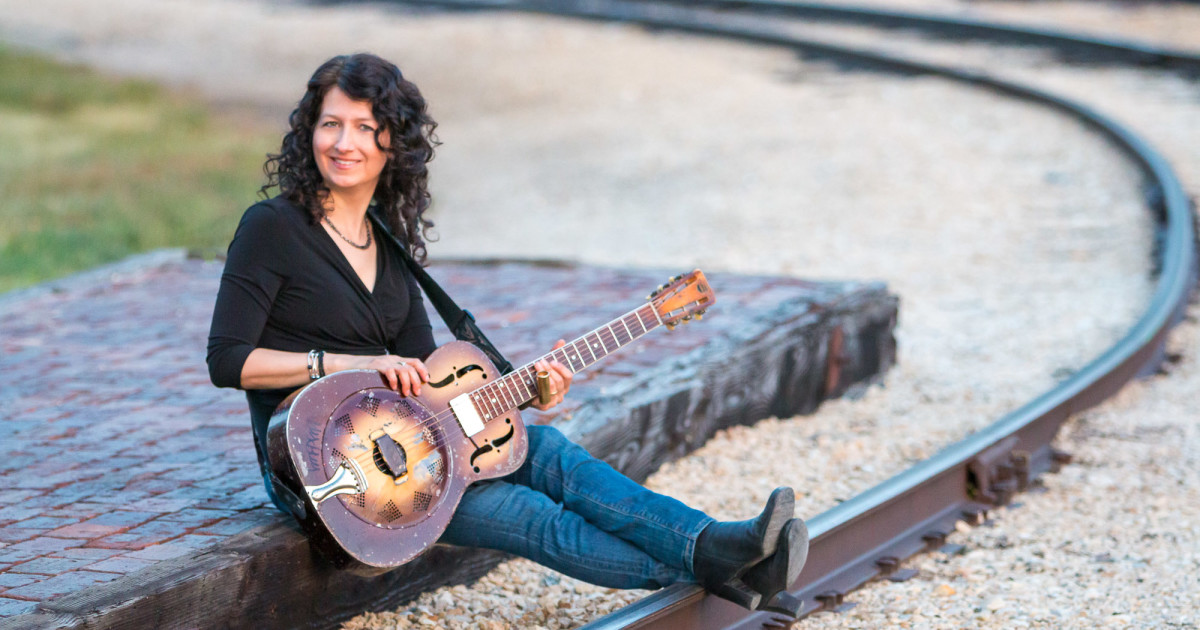
“One more thing. If you used what I told you about how I liked Lyle’s album because of the variety of solo songs and “blow out” songs with back up singers, etc. I would also want to mention that this is something that I also enjoyed when I would watch live performances of both Bobby Rush and Buddy Guy. (I play frequently at Buddy Guy’s Legends and was fortunate to have had the opportunity to have seen both Bobby and Buddy many times playing touching solo songs followed by a big blowout band performance.) That’s something that had a big impact on me and the kind of music I wanted to create.
I thought about one other thing that you may want to add to the review. I wanted to write songs with a lot of heart – that was important to me. When I got into the studio, I said that I wanted to create an album with the “spirit of Son House.” So when I was deciding on whether or not to use the songs, it was always measured up to that.”
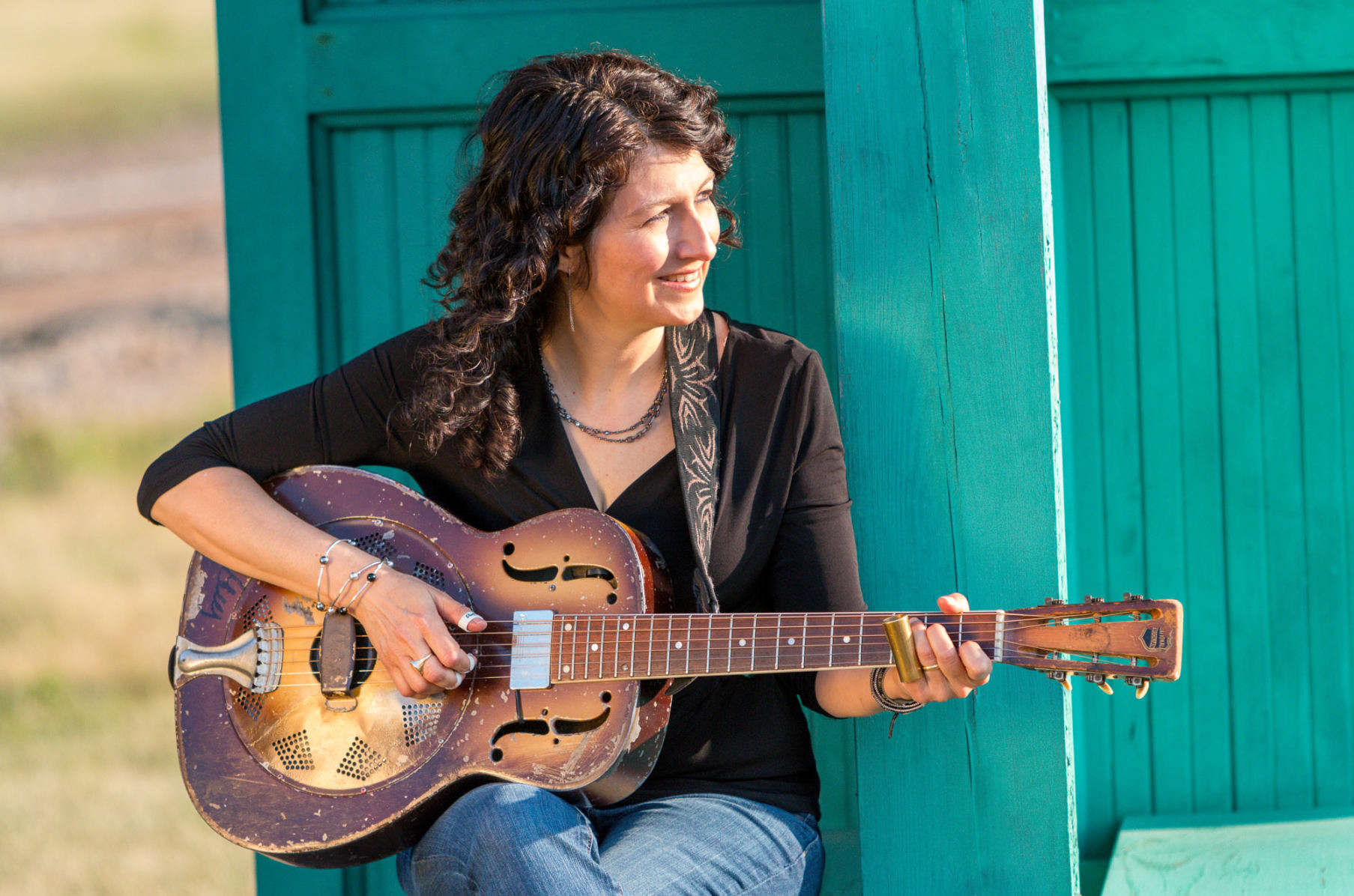

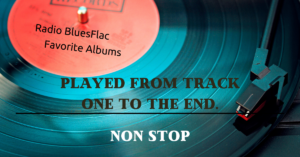
As a bonus to readers send in that favorite 21st century album, Blues album of course and it will be played eventually.
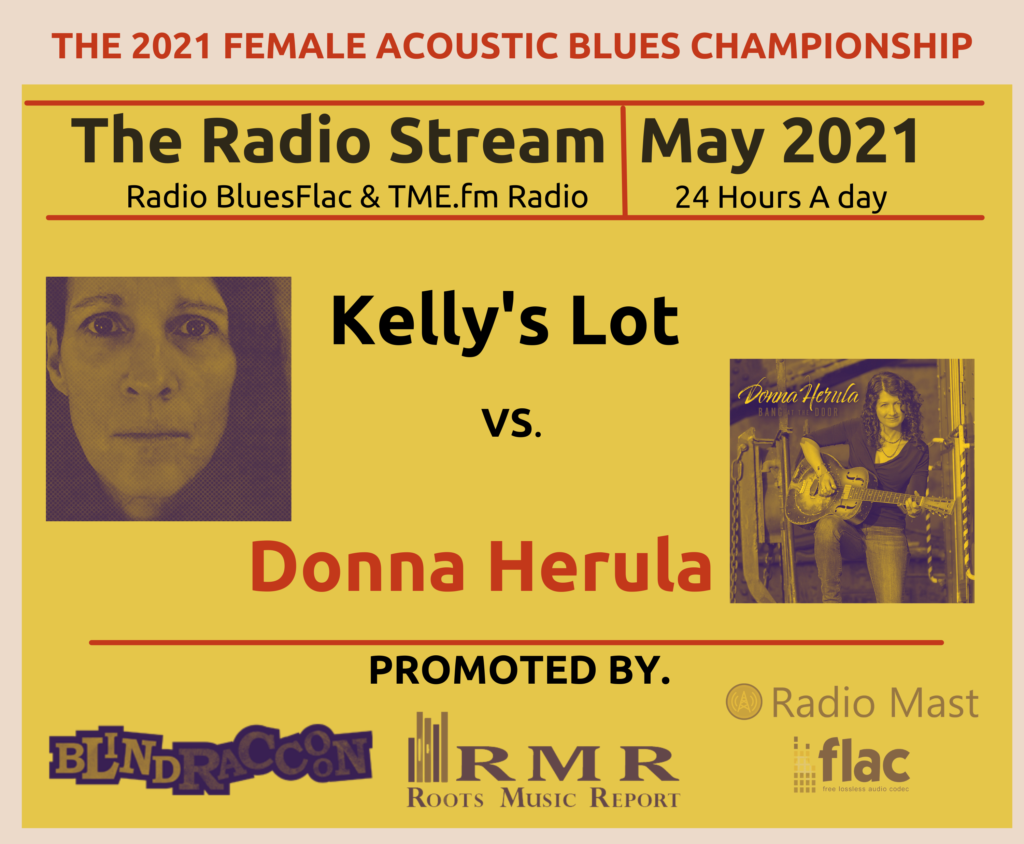
Everyone has done “The Artist of the Month”. Spun “The Album of the Week”. Chosen “The Song of the Season”.
Spotlighted everything down to the combination of nail varnish Artists wear on fingers and toes.
But not even BBC Radio 6s Chris “Snik” Hawkins has used a virtual combat between two of his favorite female Acoustic Blues Artists and their upcoming album releases as an excuse to give ’em extra airtime.
Sorry “Snikwah”, idea is © ℗®™ .
Going further no one has thought of using his Son to tweet this link to Mr. Hawkins ad infinitum ♾️ until “Snik” has sniggered and retweeted and mentioned this Virtual Sporting Event on his Morning show.
Queensbury Rules have been suspended.
Fight to the finish, probably (a) round 31 (May).
No double taps or back to back tracks from the same same artist. At least while the Referee is attentive.
Album with least number of tracks chooses corner and comes out fighting first.
No more than one hour between the end of round and “Seconds Out” for make- up repairs.
Seconds to be live-in #2’s and appear on the album in one or more roles.
According to a very small snippet in the Virtual Boxing News, the Referee enjoys looking at his collection of “signed “vinyls and CD’s as much as Rod Stewart trains. Dick. goes into a swoon when reading the ones signed “To Richard, my favorite Dick” or just ” To my favorite Dick.”
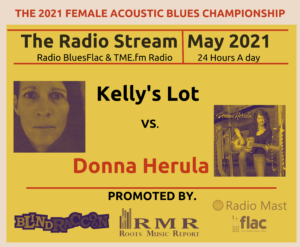
We had a Rumble in the Jungle and a Thriller in Manila in the good old 20th Century. Now in the virtual 21st we get Zirbes takes Belladonna.
Yes L.A’s Kelly’s Lot taking on Chicago’s Donna Herula in a battle of Voices, Guitars and Songwriting.
With Perry and Tony as Seconds in the corners this is a true no punches held, Mano a Mano fisticuffs.
With Donna banging at the door and Kelly asking where and when, everything is finally set up for a head to head cat fight, with the corners prepared for black eyes using black ice.
Referee (spellchecker used.) Dick “Dykspykable” Slack has been reportedly saying one contestant is “fixin’ to Die” and the other “Lost” and in “Heaven”.
The weigh-in was held in private as as not to cause any embarrassment (spellchecker again.) but rumors say there was plenty of hair pulling and eye scratching at the post weigh-in cup of tea after Donna demanded Kelly pass the biscuits and Kelly calling Donna “that fool”.
The bell for the first round starts roundabout now! so get that stream streaming and listen in to what the girls have to offer.
RED CORNER. https://www.getmeradio.com/stations/tmefmradio-1287/?station_id=1287
BLUE CORNER. https://www.getmeradio.com/stations/radiobluesflac-1288/?station_id=1288
Below are the official statistics of both contestants collated by Rick J Bowen and thanks to Copy/Paste ®™ their pro’s and con’s in their own words!
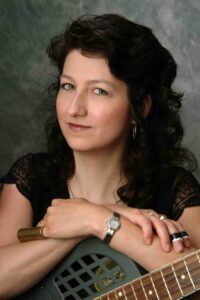
Donna Herula is a Chicago-born singer and acoustic blues slide guitarist that has a passion for playing traditional Delta and country Blues, early Chicago Blues, folk, roots, and Americana in addition to original songs. Using acoustic and electrified resonator guitars, her sound combines her love for music of the Deep South and Chicago with her love of blues guitar improvisation. Her songwriting tips the hat to the tradition while creating a fresh, contemporary perspectives on blues and roots music.
In 2016, Donna was inducted into the Chicago Blues Hall of Fame. The same year, Acoustic Guitar Magazine featured her in an article, “Down and Dirty: 10 contemporary resonator players talk about their love for that nasty sound.” In April 2018, she was featured in the Blues Blast Magazine article, Chicago Blues Guitar Women.
Donna has been a regular performer at Buddy Guy’s Legends in Chicago for the past 10 years and has opened for Buddy Guy multiple times. She has performed at the Chicago Blues Festival, King Biscuit Blues Festival, the Juke Joint Fest, the Mississippi Valley Blues Festival, the Woodstock Folk Festival, Fox Valley Folk Music and Storytelling Festival and was also the headliner at the Durban International Blues Festival in South Africa.
Donna is a guitar teacher at the Old Town School of Folk Music in Chicago where she teaches fingerstyle and slide guitar. She has taught at Blues & Swing Week at the Augusta Heritage Center of Davis & Elkins College (WV) and the Great Guitar Camp (NC). She has provided numerous Blues in the Schools and blues educational programs. She plays solo, in a duo with her husband, Tony Nardiello, and in a trio/band. Donna’s inspirations include: Son House, Fred McDowell, Muddy Waters, Johnny Winter, Lucinda Williams, Lyle Lovett, and Rory Block.
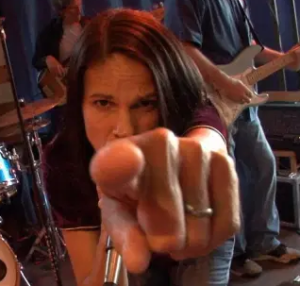
Kelly’s Lot was formed in 1994 by Kelly Zirbes, a folk singer/songwriter with a heart for the blues. With
15 CDs and lots of touring in the USA and Europe, the band celebrates 27 years since the first night the
band hit the stage at the Roxy in Hollywood. Kelly Z met guitar player and soundman, Perry Robertson in
1996, who soon after produced ‘Kelly’s Lot – Live at the Troubadour’. Within a year he joined the band,
started writing songs with Kelly Z and added the southern rock and Texas influences that have shaped
their sound.
As a duo or band, they have played coffee shops, theaters, festivals, clubs, house concerts and a variety
of events. In the last 10 years they have played as a 5–8-piece blues band that is well respected in the
American blues scene. Some of the larger festivals they have played are Waterfront Blues, Simi Valley
Cajun and Blues Festival, Ventura County Blues Festival, and Lavaudieu Music Festival. Their songs have
been heard in movies and television and covered by other artists.
Perry Robertson, who shares songwriting and band leader credits with Kelly Z, has recorded and
produced most of the band’s music including the 2019 release ‘Can’t Take My Soul’ which featured
Americana, Blues, Folk and Roots/Rock creations. In May and June of 2020, Kelly Z and Perry worked
with Doug Pettibone to record a new selection of songs, ‘ANOTHER SKY’ that also fit in
those Americana genres including six of the tracks on the album that were inspired by words from fans
on Facebook. The album charted for several months in the top 10 on the Roots Music Report
Contemporary Folk and top 20 on the Folk chart as well as in the top 50 Folk DJ chart in the fall 2020. In
2021, it was back to the Blues with Kelly and Perry working again with Pettibone to record this ‘LIVE to
Digital’ Acoustic Blues release, ‘WHERE AND WHEN’ that releases on June 11.
TRACK NOTES FROM KELLY
1) Stronger – Kelly and Perry were inspired to write this song by everything happening in the world. So
many are feeling down, depressed, and trapped. We wanted to remind them that maybe these
challenges will make us all stronger. A hopeful song to help us come out of a tough situation.
2) Somebody In My Home – Kelly chose this song from Howlin’ Wolf for its slow-moving groove and
message about infidelity and who’s to blame. We all want love in a relationship but without it we may
stray. Howlin’ Wolf writes the lyrics as the person who didn’t love their partner enough, which created a
path for his lover to welcome someone else into his home.
3) Heaven – Kelly wrote the lyrics to this song after hearing Perry fiddling around on the guitar. Took
them about 15 minutes from fiddling to finishing the song. They like to think of this song as a spiritual
that doesn’t want to surrender. The truth is we don’t want to miss out on things when it is our time to
leave this earth.
4) Jealous Hearted Love – Lovie Austin wrote this, and Ma Rainey made it known. It’s one of Kelly’s
favorite Ma Rainey tunes and Lovie’s lyrics about jealousy makes for some smiles instead of the ‘pit in
your stomach’ jabs you get when you feel it.
5) Lost – Perry challenged Kelly with a few guitar riffs to sing slower than she was used to and these
words just came out. Depression is universal and those who feel it also know what it’s like to be lost.
6) Nature – Another great twist by Howlin’ Wolf. His lyrics explain how it is natural for a man to be lookin’
around or even being unfaithful. The twist is singing it as a woman who also has that choice. The upbeat
vibe makes for a little fun.
7) Where And When – This song was written for a project Kelly did about grief. But it was also inspired by
the idea that we don’t spend enough time with each other.
8) Stones In My Passway – Kelly knew she had to do this song by Robert Johnson because everyone can
find a message in these lyrics. We all have stuff that gets in our way including those who love us and
promise to respect us. You can also find a darker message too if you look for it, but it will come from
your own experience because these lyrics let you do that!
9) That Fool – Kelly and Perry wrote this to express the deep sorrow of loving someone who doesn’t love
you back and the quest to find a way to stop doing it.
10) Black Eye Blues – The hard part about covering this song is Kelly’s mother lived the same experience
as ‘Miss Nancy Ann’. Domestic violence is too common of a thread in our world, but these lyrics and
upbeat music give some hope in finding strength and hopefully making the decision to leave
11) Ship – The phrase, “My ship is about to come in” morphed into this song about waiting for your ship
when all along it is waiting for you to get on board.
TRACK NOTES FROM DONNA
The after fight press conferences will also be held “in camera” and no cameras allowed.
There will be no questions asked and an Official Press Release will be passed round.
Finally a round by round summary will be posted here after being written with two of the three most influential voices in my life resonating in my head.
Proudly dedicated to Eammon Andrews, Harry Carpenter and “mi Dad” whose knee I sat on to listen to the Boxing. “Why Dad?”
